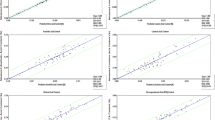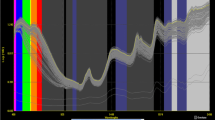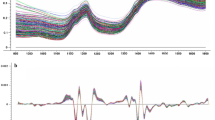Abstract
Tree peonies (Paeonia Sect Moutan DC) are an emerging oil crop because of their high oil and α-linolenic acid (ALA) content. This research was to investigate the potential use of near infrared reflectance spectroscopy (NIRS) for estimating the major fatty acids contents, such as palmitic acid (C16:0), oleic acid (C18:1), linoleic acid (C18:2) and linolenic acid (C18:3) in tree peonies. A total of 115 small seed samples and 447 single seeds were selected to calibrate the predictive models. NIRS absorbance spectra were collected using a Fourier transform near infrared (FT-NIR) spectrometer for the small seed samples, and acousto-optic tunable filter-near infrared (AOTF-NIR) for the single seed samples. Statistical analysis was performed with partial least squares (PLS). For the husked samples, C18:3, C18:1 and C18:2 showed the highest correlation coefficient of validation (R v; = 0.9756, 0.9467 and 0.8485, respectively) and the ratio of performance to deviation (RPD; = 3.58, 1.91 and 2.17, respectively); however, C16:0 did not reach expectations (R v = 0.7783, RPD = 1.32). For intact samples, C18:3 showed the best prediction (R v = 0.9096, RPD = 3.14), followed by C18:2 (R v = 0.8479, RPD = 1.96). The results for C18:1 were poor (R v = 0.7237, RPD = 1.70). For single seeds, only the results for C18:3 (R = 0.9150, RPD = 1.73) were good in the husked seed samples. It was concluded that NIRS can be used to rapidly assess the content of the major fatty acids in small samples.





Similar content being viewed by others
References
Li SS, Yuan RY, Chen LG, Wang LS, Hao XH, Wang LJ, Zheng XC, Du H (2015) Systematic qualitative and quantitative assessment of fatty acids in the seeds of 60 tree peony (Paeonia section Moutan DC.) cultivars by GC–MS. Food Chem 173:133–140
Han JG, Li XQ, Liu Z, Hu YH (2014) Potential applications of tree peony as an oil plant. Cereals Oils 5:21–25 (in Chinese)
Shi GA, Jiao FX, Jiao YP, Yang HA, Han MW, Wu YQ, Shi BR (2014) Development prospects and strategies of oil tree peony industry in China. J Chin Cereals Oils Assoc 29:124–128 (in Chinese)
Li JJ, Zhang XF, Zhao XQ (2011) Tree peony of China. Encyclopaedia of China Publishing House, Beijing, pp 17–44 (in Chinese)
Cheng FY, Li JJ, Chen DZ, Zhang ZS (2005) Chinese Flare Mudan. China Forestry Publishing House, Beijing, pp 77–83 in Chinese)
Guo BL, Hong DY, Xiao PG (2008) Further research on chemotaxonomy of paeonol and analogs in Paeonias (Ranunculaceae). J Systmat Evolut 46:724–729
Yuan JH, Cornille A, Giraud T, Cheng FY, Hu YH (2014) Independent domestications of cultivated tree peonies from different wild peony species. Mol Ecol 23:82–95
Hom NH, Becker HC, Möllers C (2006) Non-destructive analysis of rapeseed quality by NIRS of small seed samples and single seeds. Euphytica 153:27–34
Sato T, Takahata Y, Noda T, Yanagisawa T, Morishita T, Sakai S (1995) Nondestructive determination of fatty acid composition of husked sunflower (Helianthus annua L.) seeds by near-infrared spectroscopy. J Am Oil Chem Soc 72:1177–1183
Huang YY, Zhu LW, Li JH, Wang JH, Sun BQ, Sun Q (2011) Rapid and nondestructive discrimination of hybrid maize seed purity using infrared spectroscopy. Spectrosc Spectra Anal 3:661–664 (in Chinese)
Niewitetzki O, Tillmann P, Becker HC, Möllers C (2010) A new near-infrared reflectance spectroscopy method for high-throughput analysis of oleic acid and linolenic acid content of single seeds in oilseed rape (Brassica napus L.). J Agric Food Chem 58:94–100
Leonardo V, Begona PR, Nez JMFN (2004) Use of near-infrared reflectance spectroscopy for selecting for high stearic acid concentration in single husked achenes of sunflower. Crop Sci 44(1):93–97
Rudolphi S, Becker HC, Schierholt A, von Witzke-Ehbrecht S (2012) Improved estimation of oil linoleic and oleic acid and seed hull fractions in safflower by NIRS. J Am Oil Chem Soc 89:363–369
Quampah A, Huang ZR, Wu JG, Liu HY, Li JR, Zhu SJ, Shi CH (2012) Estimation of oil content and fatty acid composition in cottonseed kernel powder using near infrared reflectance spectroscopy. J Am Oil Chem Soc 89:567–575
Xi RC, Zhong YM, Deng XM, Chen XY, Mo BY, Yi LF (2013) Models for determining oil contents in Camellia oleifera seeds by using near infrared spectroscopy. Sci Silvae Sin 4:1–6 (in Chinese)
Velasco L, Llers CM, Becker HC (1999) Estimation of seed weight, oil content and fatty acid composition in intact single seeds of rapeseed (Brassica napus L.) by near-infrared reflectance spectroscopy. Euphytica 106:79–85
Kovalenko IV, Rippke GR, Hurburgh CR (2006) Measurement of soybean fatty acids by near-infrared spectroscopy: linear and nonlinear calibration methods. J Am Oil Chem Soc 83:421–427
Kovalenko IV (2005) Determination of amino and fatty acid composition of soybeans using near-infrared spectroscopy. Iowa State University, Iowa
Yang H, Irudayaraj J, Paradkar M (2005) Discriminant analysis of edible oils and fats by FTIR, FT-NIR FT-Raman spectroscopy. Food Chem 93:25–32
Kasemsumran S, Thanapase W, Punsuvon V, Ozaki Y (2012) A feasibility study on non-destructive determination of oil content in palm fruits by visible-near infrared spectroscopy. J Near Infrared Spectrosc 20:687–694
Sato T, Uezono I, Morishita T, Tetsuka T (1998) Nondestructive estimation of fatty acid composition in seeds of Brassica napus L. by near-infrared spectroscopy. J Am Oil Chem Soc 75:1877–1881
Acknowledgments
The authors are grateful to Prof. Han Donghai, College of Food Science & Nutritional Engineering, China Agricultural University, for NIRS instruments support and Mr Cheng Xinyun, Beijing National Beauty Tree peony Technology Co. Ltd., for experimental materials support. This work was financially supported by the National Science and Technology Support Program of China (2012BAD01B07), and the Key Technology Research of Oil Peony Industry in Shaanxi Province (2014HXFWYL016).
Author information
Authors and Affiliations
Corresponding author
Additional information
This study investigates the potential use of near infrared reflectance spectroscopy (NIRS) as a rapid screening method to estimate the major fatty acids contents, such as palmitic acid (C16:0), oleic acid (C18:1), linoleic acid (C18:2) and linolenic acid (C18:3) in tree peonies.
About this article
Cite this article
Huliang, C., Fangyun, C. & Liping, P. Determination of the Fatty Acid Composition in Tree Peony Seeds Using Near-Infrared Spectroscopy. J Am Oil Chem Soc 93, 943–952 (2016). https://doi.org/10.1007/s11746-016-2839-0
Received:
Revised:
Accepted:
Published:
Issue Date:
DOI: https://doi.org/10.1007/s11746-016-2839-0




